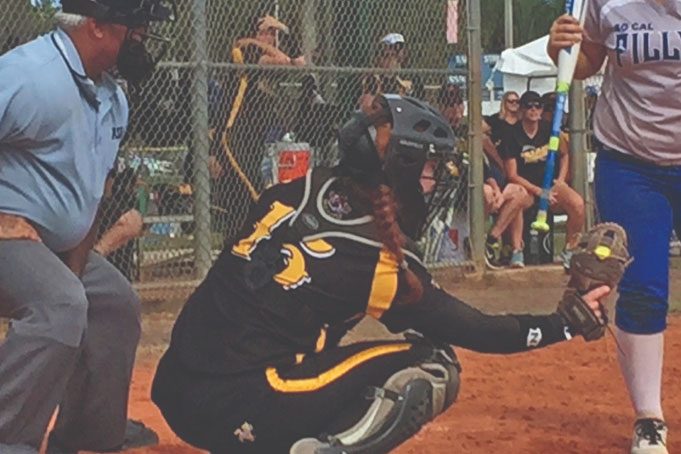As you arrive at the diamond for a day of calling balls and strikes, nothing seems unusual. You go through pregame rituals, put the equipment on, conduct a pregame meeting with your partner and then check equipment after walking onto the field.
Following the plate meeting with both coaches, you might stand through the announcement of lineups, maybe even the national anthem. Then it’s game time — and then you notice something unusual with the player in front of you: you’ve got a southpaw catcher.
Just because she receives with a different hand doesn’t mean you should change how you call the game. Au contraire, mon frère. Whether you’re just starting out in the gig or you’ve been working the plate for 40 years, the goal’s the same.
“You track the ball,” longtime high school and college umpire John Wayne Martin of Chilhowie, Va., said. “It doesn’t change anything for me. Doesn’t matter if it’s a righty or lefty, you’re calling the ball, not the glove.”
Still, there are umpires such as Alan McCullough of Sacramento, Calif., who will make adjustments for a left-handed catcher. He was one of 12 selected to work the Junior Softball World Series in Kirkland, Wash., in August.
If McCullough is working the plate with a lefty in front of him, he’ll work off the catcher as much as he does the pitch.
“I use where the catcher sets up before the pitch is ever tossed to help me gauge the (pitch),” he said. “If she is right on a corner and then doesn’t move the glove during the pitch, I’ve got a strike.”
Longtime MLB crew chief Gerry Davis says a key to successfully working the plate is catching the ball with your eyes. No matter what technique one uses, whether it’s Davis’ or using the catcher as a guide, you must be more careful with a lefty backstop.
“The first few pitches when a lefty reaches across on a right-handed batter to grab that inside corner really throw me,” McCullough said. “That’s when I realize it’s time to re-focus, start over and spend more time tracking rather than receiving.”
For some umpires, the trickiest thing about working behind lefty catchers can be judging the outside corner to right-handed batters. Because a lefty’s glove will never touch the corner on borderline pitches, there can be a temptation to deny the pitcher that critical part of the plate.
Lop just an inch or two off the strike zone’s outer part and it can completely turn the game around. That’s why most umpires believe tracking the ball is a must when working in back of a lefty.
“There’s no difference to me, because I’m trying to do the same thing with a righty or lefty (catcher),” said Jack Taylor of Gate City, Va.
A veteran of more than 30 years on the softball field, Taylor works every level from high schools to Little League and is Virginia’s Little League umpire consultant. While his strike zone doesn’t change, Taylor will make one adjustment with a left-hander catching.
“I make sure I stay out of the way when that left hand goes up to throw the ball so I don’t have umpire’s interference,” he said. “You just have to watch what you are doing in that game.”
Rich Bavilacqua, Riverview, Fla., seconds Taylor’s view on being vigilant in preventing interference. Not just his but others’.
“The majority of batters are right-handed and as the plate umpire you might need to watch it closely,” he said. “They aren’t used to having a catcher release the throw closest to them, so you might get an interference call.”
Left-handed catchers are almost non-existent at all levels of baseball. There have only been eight in major league history, the last being Benny Distefano, who caught six innings over parts of three games for the 1989 Pittsburgh Pirates.
But they are a touch more common in softball, largely because the game still emphasizes speed and quickness. Many coaches like to play the “short game,” meaning that they build the offense around lefty hitters who bunt and slap their way on base and let the power bats bring them home.
To combat that style of play, a catcher has to possess quick reactions. A lefty catcher who can clear the plate immediately will derive a major advantage throwing to first because he or she doesn’t have to aim it around the batter-runner.
Other than the novelty of a lefty catcher, though, the task for the man or woman behind her doesn’t change.
“All is the same calling balls and strikes,” Bavilacqua said.
What's Your Call? Leave a Comment:
Note: This article is archival in nature. Rules, interpretations, mechanics, philosophies and other information may or may not be correct for the current year.
This article is the copyright of ©Referee Enterprises, Inc., and may not be republished in whole or in part online, in print or in any capacity without expressed written permission from Referee. The article is made available for educational use by individuals.



















